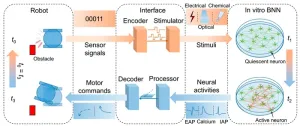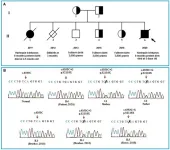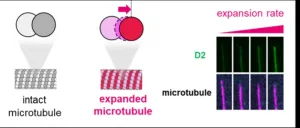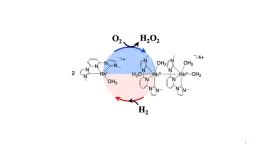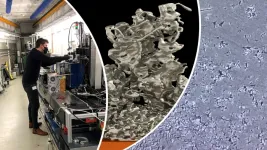A review paper by scientists at the Beijing Institute of Technology summarized recent efforts and future potentials in the use of in vitro biological neural networks (BNNs) for the realization of biological intelligence, with a focus on those related to robot intelligence.
The review paper, published on Jan. 10 in the journal Cyborg and Bionic Systems, provided an overview of 1) the underpinnings of intelligence presented in in vitro BNNs, such as memory and learning; 2) how these BNNs can be embodied with robots through bidirectional connection, forming so-called BNN-based neuro-robotic systems; 3) preliminary intelligent behaviors achieved by these neuro-robotic systems; and 4) current trends and future challenges in the research area of BNN-based neuro-robotic systems.
“our human brain is a complex biological neural network (BNN) composed of billions of neurons, which gives rise to our consciousness and intelligence. However, studying the brain as a whole is extremely challenging due to its intricate nature. By culturing a part of the neurons from the brain in a Petri dish, simpler BNNs, such as mini-brains, can be formed, allowing for easier observation and investigation of the network. These mini-brains may provide valuable insights into the enigmatic origins of consciousness and intelligence.” explained study author Zhiqiang Yu, an assistant researcher at the Beijing Institute of Technology.
“Interestingly, mini-brains are not only structurally similar to human brains, but they can also learn and memorize information in a similar way.” said Yu. In particular, these in vitro BNNs share the same basic structure as in vivo BNNs, where neurons are connected through synapses, and they exhibit short-term memory through fading and hidden memory processes. Additionally, these mini-brains can perform supervised learning and be trained to respond to specific stimuli signals. Recently, researchers have demonstrated that in vitro BNNs can even accomplish unsupervised learning tasks, such as separating mixed signals. “This fascinating ability may have something to do with the famous free energy principle. That is, these BNNs have a tendency to minimize their uncertainty about the outer world,” said Yu.
These abilities of in vitro BNNs are quite intriguing. However, only having such a ‘mini-brain’ on your hand is not enough for the rise of consciousness and intelligence. Our brain relies on our body to perceive, comprehend, and adapt to the outside world, and similarly, these mini-brains require a body to interact with their environment. A robot is an ideal candidate for this purpose, leading to a burgeoning interdisciplinary field at the intersection of neuroscience and robotics: BNN-based neuro-robotic systems.
“A stable bidirectional connection is a prerequisite for these systems.” said study authors, "In this review, we summarize the mainstream means of constructing such a bidirectional connection, which can be broadly classified into two categories based on the direction of connection: from robots to BNNs and from BNNs to robots." The former involves transmitting sensor signals from the robot to BNNs, utilizing electrical, optical, and chemical stimulation methods, while the latter records the neural activities of BNNs and decode these activities into commands to control the robot, using extracellular, calcium, and intracellular recording techniques.
"Embodied by robots, in vitro BNNs exhibit a wide range of fascinating intelligent behaviors," according to Yu. "These behaviors include supervised and unsupervised learning, memorization, mobile object tracking, active obstacle avoidance, and even learning to play games such as 'Pong'."
The intelligent behaviors displayed by these BNN-based neuro-robotic systems can be divided into two categories based on their dependence on either computing capacity or network plasticity, as explained by Yu. "In computing capacity-dependent behaviors, learning is unnecessary, and the BNN is regarded as an information processor that generates specific neural activities in response to stimuli. However, for the latter, learning is a crucial process, as the BNN adapts to stimuli and these changes are integral to the behaviors or tasks performed by the robot," added Yu.
To facilitate easy comparison of the recording and stimulation techniques, encoding and decoding rules, training policies, and robot tasks, representative studies from these two categories have been compiled into two tables. Additionally, to provide readers with a historical overview of BNN-based neuro-robotic systems, several noteworthy studies have been selected and arranged chronologically.
The study authors also discussed current trends and main challenges in the field. According to Yu, "Four challenges are keen to be addressed and are being intensely investigated. How to fabricate BNNs in 3D, thereby making in vitro BNNs close to their in vivo counterparts, is the most urgent one of them"
Perhaps the most challenging aspect is how to train these robot-embodied BNNs. The study authors noted that BNNs are composed only of neurons and lack the participation of various neuromodulators, which makes it difficult to transplant various animal training methods to BNNs. Additionally, BNNs have their own limitations. While a monkey can be trained to ride a bicycle, it is much more challenging to accomplish tasks that require higher-level thought processes, such as playing Go.
“The mystery of how consciousness and intelligence emerge from the network of cells in our brains still eludes neuroscientists” said Yu. However, with the development of embodying in vitro BNNs with robots, we may observe more intelligent behaviors in them and bring people closer to the truth behind the mystery.
Authors of the paper include. Zhe Chen, Qian Liang, Zihou Wei, Xie Chen, Qing Shi, Zhiqiang Yu*, and Tao Sun
The paper, "An Overview of In Vitro Biological Neural Networks for Robot Intelligence," was published in the journal Cyborg and Bionic Systems on January 10, 2023, at DOI: https://doi.org/ 10.34133/cbsystems.0001
Reference
Authors: Zhe Chen1,2,3, Qian Liang2,3,4, Zihou Wei2,3,4, Xie Chen2,3,4, Qing Shi1,2,3,4, Zhiqiang Yu2,3,4, and Tao Sun2,3,4
Title of original paper: An Overview of In Vitro Biological Neural Networks for Robot Intelligence
Journal: Cyborg and Bionic Systems
DOI: 10.34133/cbsystems.0001
Affiliations:
1School of Medical Technology, Beijing Institute of Technology, Beijing 100081, China.
2Key Laboratory of Biomimetic Robots and Systems (Beijing Institute of Technology), Ministry of Education, Beijing 10081, China.
3Advanced Innovation Center for Intelligent Robots and Systems, Beijing Institute of Technology, Beijing 100081, China.
4School of Mechatronical Engineering, Beijing Institute of Technology, Beijing 100081, China
A brief introduction about yourself.
About Dr. Zhiqiang Yu:
Zhiqiang Yu, currently an Assistant Researcher at the School of Mechatronical Engineering, Beijing Institute of Technology, obtained his B.S. degree in Mechatronics from Yantai University, Shandong, China in 2013, and his Ph.D. degree in Mechatronics from Beijing Institute of Technology in 2016. His research interests primarily revolve around micro/nano robotics, as well as biomimetic sensors and robots.
Personal Homepage: https://www.researchgate.net/profile/Zhiqiang-Yu-11
END
